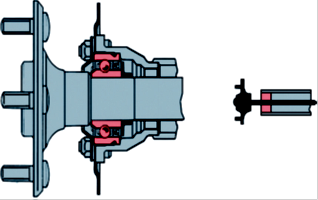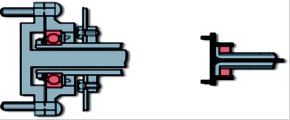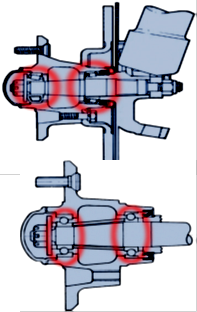Wheel Bearings
Introduction:
Two main types of bearing are used in rear wheel hubs: ball and roller (or tapered roller) bearings.
Axle shafts:
Axle shafts transmit drive from the differential to the rear wheel hubs. An axle shaft has to withstand:
● Torsional stress due to driving and braking forces
● Shear and bending stress due to the weight of the vehicle
● Tensile and compressive stress due to cornering forces
A number of bearing layouts are used on the fixed live axle (driven) of a rear wheel drive car, to handle these stresses.
Wheel bearing: semi-floating: 
- Figure shows a typical axle mounting used on many rear-wheel drive cars. A single bearing is used, which is mounted in the axle casing.
- With this design, the axle shaft has to withstand all the operating forces. The shaft is therefore strengthened and designed to do this.
- An oil seal is incorporated because oil from the final drive can work its way along the shaft.
- The seal prevents the brakes being contaminated.
Wheel bearing: three-quarter floating

The three-quarter floating bearing reduces the main shear stresses on the axle shaft but the other stresses remain. The bearing is mounted on the outside of the axle tube. An oil seal is included to prevent the brake linings from being contaminated.
Wheel bearing: fully floating

- Fully floating systems are generally used on heavy or off-road vehicles. This is because the stresses on these applications are greater.
- Two widely spaced bearings are used, which take all the loads, other than torque, off the axle shaft. Bolts or studs are used to connect the shaft to the wheel hub.
- When these are removed, the shaft can be taken out without jacking up the vehicle.
Front hub (rear-wheel drive) with tapered roller bearings

The front hubs on rear-wheel drive cars consist of two bearings. These are either ball or tapered roller. The roller types are generally used on earlier vehicles. They have to be adjusted by tightening the hub nut and then backing it off by about half a turn.
Front hub with ball bearings
The more modern hub bearings, known as contact-type ball races, do not need adjusting. This is because the hub nut tightens against a rigid spacer. This nut must always be set at a torque specified by the manufacturer.
- The most common systems for rear-wheel drive cars are semi-floating rear bearings at the rear and twin ball bearings at the front.
- The front bearings are designed to withstand side forces as well as vertical loads.
- Front-wheel drive cars have a dead axle at the rear so, typically, two taper bearings are used, or a double-race ball bearing